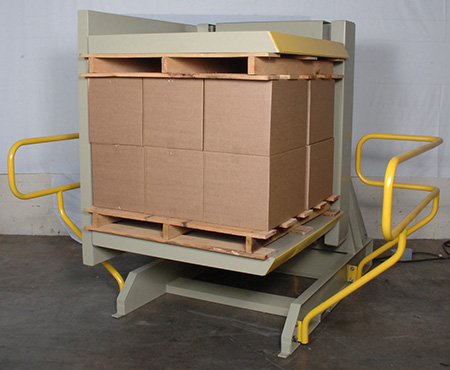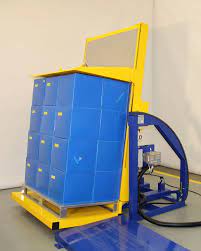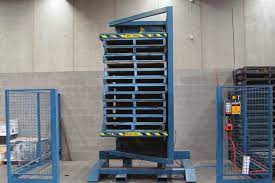Meeting Precision Automation In Lean Manufacturing Plants Requirements in Germany with Automated Pallet Exchange
Are your manufacturing lines struggling to keep up with the demands for precision and speed? In highly competitive markets like Germany, even small inefficiencies can have a big impact. Manual pallet handling often creates a hidden bottleneck, slowing down production, increasing safety risks, and undermining your investment in automation. This manual step can introduce errors, cause product damage, and lead to worker injuries. It is a persistent problem that works directly against the principles of lean manufacturing and Industry 4.0. The solution is to address this gap directly with technology designed for the task. An automated pallet exchange system integrates into your workflow, removing the manual bottleneck and unlocking new levels of efficiency and safety.
An automated pallet exchange meets the rigorous requirements of lean manufacturing in German plants by systematically eliminating waste, enhancing process flow, and supporting high-precision automation. It directly targets waste (Muda) in motion, waiting, and potential defects from manual handling. The system improves production leveling (Heijunka) by creating a consistent cycle time. It also elevates built-in quality (Jidoka) by ensuring gentle, repeatable, and safe product handling. This integration results in higher throughput, lower operational costs, and a safer work environment.

This sounds great in theory. But you are likely wondering how this technology works in the real world. How does it solve the specific challenges you face on your factory floor every day? I have seen these systems transform operations for many clients. I started my career on the factory floor and later built my own packing machine factory, SHJLPACK. That journey taught me the value of practical solutions. Let's break down how this works so you can see the benefits for your own plant.
How does an automated pallet exchange address the core principles of lean manufacturing?
You have likely invested significant time and resources into implementing lean principles. But a single manual process can disrupt your entire system. Pallet handling is often that hidden weak link. It forces your highly automated lines to pause. It creates unnecessary movement for your staff. This is a constant source of inefficiency. Every moment a machine waits for a pallet swap, your lean system is failing. This isn't just a small delay. It is a fundamental break in the continuous flow you work so hard to achieve. The costs add up quickly. But there is a direct solution. Automated pallet exchangers are designed specifically to eliminate these forms of waste, making your lean system perform as intended.
An automated pallet exchange directly supports core lean manufacturing principles by targeting the "seven wastes" for elimination. It significantly reduces unnecessary transport of goods, cuts down on waiting time for machines, minimizes excess motion by workers, and prevents defects caused by rough manual handling. This creates a smoother, more predictable, and continuous workflow, which is the ultimate goal of any lean initiative.

Dive Deeper: Integrating Automation with Lean Philosophy
When I first started as an engineer, the concepts of lean manufacturing were my guide. The goal was always to identify and eliminate waste. I saw firsthand how a simple, repetitive, manual task could bring a multi-million dollar production line to a halt. This is why I believe so strongly in targeted automation. An automated pallet exchanger is not just a machine; it's a lean manufacturing tool.
Eliminating Waste (Muda)
The core of lean is removing "Muda," or waste. An automated pallet exchanger attacks several types of waste at once.
- Waiting: Your production line should never have to wait for a person to manually swap a pallet. An automated system performs the exchange in a predictable, short cycle, feeding the line continuously.
- Transport: It reduces the need for forklifts to travel long distances just to move pallets. The system can be placed directly in the line, minimizing movement.
- Motion: Think of the physical actions of a worker: bending, lifting, turning, and positioning. An automated exchanger eliminates these strenuous and non-value-added motions. This protects your workers and frees them for more complex tasks.
- Defects: Manual handling can be rough. Products get dropped, boxes get crushed, and loads become unstable. An automated system uses smooth, controlled pressure and motion, which drastically reduces the risk of product damage.
Improving Flow (Heijunka)
"Heijunka" is about leveling production to create a smooth, continuous flow. Manual processes are, by nature, variable. One operator might be faster than another. An operator might be tired at the end of a shift. This variability creates bottlenecks. An automated pallet exchanger has a fixed cycle time. It performs the same task in the same amount of time, every single time. This predictability makes your entire production schedule more stable and reliable.
| Metric | Manual Pallet Exchange | Automated Pallet Exchange |
|---|---|---|
| Cycle Time | Variable (2-5 minutes) | Consistent (e.g., 60 seconds) |
| Labor Requirement | 1-2 operators + forklift | 0 (Supervisory only) |
| Process Control | Low (depends on operator) | High (PLC controlled) |
| Damage Risk | Moderate to High | Very Low |
| Flow Disruption | High | Minimal / None |
Building in Quality (Jidoka)
"Jidoka" means automation with a human touch, or intelligent automation. A good automated system doesn't just perform a task blindly. It has sensors and controls to detect problems. For example, if a pallet is misaligned or a product is out of place, the pallet exchanger can stop the process and alert an operator. This prevents a defective unit from continuing down the line, saving you money and protecting your brand's reputation for quality.
What are the specific challenges German manufacturing plants face that automated pallet exchangers can solve?
Germany is a global leader in high-quality manufacturing. I have always admired the precision and engineering that comes from the region. But this leadership position brings unique pressures. High labor costs, very strict workplace safety rules, and the constant demand for perfection are daily realities. Trying to manage these pressures with manual processes is a difficult battle. Manual labor is expensive. A single workplace injury can lead to significant costs and stop production. A small mistake in handling can damage a high-value product. You are constantly fighting to control these variables. Automated pallet exchangers are a powerful tool in this fight. They are engineered to solve these exact challenges head-on.
Automated pallet exchangers solve critical challenges in German manufacturing by reducing the dependence on expensive manual labor. They help ensure full compliance with Germany's strict ergonomic and safety standards, such as the Betriebssicherheitsverordnung. They also provide the consistent, gentle, and precise handling required for the high-value goods that are the hallmark of German industry.

Dive Deeper: A Solution for a High-Stakes Environment
Germany's "Mittelstand" is famous for its specialized, family-owned manufacturing businesses. They succeed by focusing on quality and efficiency. My own journey from employee to factory owner taught me that success depends on making smart investments that address your biggest cost drivers and risks. In Germany, labor and compliance are at the top of that list.
The High-Cost Labor Challenge
Labor costs in Germany are among the highest in the world. When you have an employee performing a simple, repetitive task like swapping pallets, you are not using that person's skills effectively. That high hourly wage is being spent on a non-value-added task. An automated pallet exchanger takes over this job. It works 24/7 without breaks or shift changes. The human worker can then be moved to a more valuable role, such as quality control, machine maintenance, or process supervision. This isn't about replacing workers. It is about elevating their work and making your entire operation more productive. For a CEO like Javier Morales, reallocating human capital to higher-value activities is a major strategic win.
Navigating Strict Safety and Ergonomic Regulations
Germany's workplace safety regulations are comprehensive and strictly enforced. The Betriebssicherheitsverordnung (Ordinance on Industrial Safety and Health) places a strong emphasis on risk assessment and eliminating hazards at the source. Manual handling of heavy loads is a primary source of musculoskeletal disorders, particularly back injuries. These injuries are costly, leading to lost workdays, insurance claims, and potential legal issues. An automated pallet exchanger removes the worker from this hazardous task entirely. The system is enclosed with safety fencing, light curtains, and automatic locks to ensure it cannot operate when a person is in the area. By automating, you are not just improving efficiency; you are designing a fundamentally safer workplace and ensuring compliance.
Maintaining Precision for High-Value Products
German manufacturing is defined by its quality. Whether it's automotive components, medical devices, or complex machinery, the products are high-value and require careful handling. I once worked with a client in the electronics sector. Their main problem was not speed, but tiny cracks in their circuit boards caused by jarring during manual pallet changes. An automated pallet exchanger solved this. It uses controlled, even pressure to clamp the load and rotates it smoothly. There are no sudden drops or impacts. After installation, their product damage rate from handling fell to nearly zero. This is the level of precision that automation brings, protecting your products and your profits.
How do you calculate the ROI for an automated pallet exchange system in a high-cost environment?
As a business owner, every investment decision comes down to the numbers. An investment in new equipment can seem expensive. You need to know: what is the real return on this investment (ROI)? It can feel like a complicated question with too many variables. If you cannot clearly explain the financial benefits, it is difficult to approve the spending. This uncertainty can lead to delays. Meanwhile, your operational costs remain high and your competitors might be gaining an edge by automating. The good news is that calculating the ROI for a pallet exchanger is very direct. I will show you how to break it down into simple, measurable savings and gains that will make the business case clear.
To calculate the ROI for an automated pallet exchanger, you need to sum up all the annual financial benefits and divide that number by the total investment cost. The key benefits to measure are direct labor savings, the cost of eliminated product damage, the value of increased throughput, and the financial savings from improved workplace safety and lower insurance premiums.

Dive Deeper: Making the Financial Case
When I started my own factory, I had to be very careful with my money. I couldn't afford any investment that didn't pay for itself quickly. I learned to analyze every purchase not by its price tag, but by its potential to generate value. This is how you should look at an automated pallet exchanger. Let's build a sample ROI calculation for a typical German manufacturing plant.
Quantifying Direct Cost Savings
These are the easiest savings to measure. They are the hard costs you will no longer have to pay.
| Cost Category | Calculation | Example (Annual Savings) |
|---|---|---|
| Direct Labor Savings | (Operators) x (Hourly Wage + Benefits) x (Hours/Day) x (Workdays/Year) | 1 Operator x €30/hr x 8 hrs x 250 days = €60,000 |
| Product Damage Reduction | (Value of Goods Damaged/Month) x (Reduction %) x 12 | €2,000/month x 80% reduction x 12 = €19,200 |
| Workplace Safety Savings | (Avg. Cost of Injury) x (Reduced Incidents/Year) + Insurance Premium Reduction | €30,000/claim x 0.1 reduction + €2,000 = €5,000 |
This table shows that just by reducing direct costs, the savings can be substantial. For a CEO like Javier, who is focused on reducing operational costs by 8%, these numbers are very compelling.
Calculating Gains from Increased Efficiency
These gains come from producing more with the same resources.
- Increased Throughput: If your line is no longer waiting for pallet swaps, you can produce more. Let's say you eliminate 30 minutes of downtime per shift. In that time, you could produce 100 extra units. If your profit per unit is €2, that's an extra €200 per shift. Over a year, this adds up.
- (€200/shift) x (2 shifts/day) x (250 days/year) = €100,000 in additional profit.
- Unlocking Bottlenecks: This is the most powerful benefit. Your entire production line is only as fast as its slowest point. If manual pallet handling is that slowest point, it doesn't matter how fast your other machines are. By removing that bottleneck, you unlock the true capacity of your entire investment.
A Sample ROI Calculation
Now, let's put it all together.
-
Total Investment:
- Machine Cost: €65,000
- Installation & Integration: €10,000
- Training: €5,000
- Total Investment Cost = €80,000
-
Total Annual Savings & Gains:
- Labor Savings: €60,000
- Damage Reduction: €19,200
- Safety Savings: €5,000
- Increased Throughput Value: €100,000
- Total Annual Benefit = €184,200
-
Payback Period:
- (Total Investment) / (Total Annual Benefit) = (€80,000) / (€184,200) = 0.43 Years, or about 5 months.
A payback period of less than six months is an incredibly strong financial argument. It changes the conversation from "Can we afford this?" to "How soon can we install this?".
What are the key considerations when integrating a pallet exchanger into an existing automated production line?
You have analyzed the benefits and the ROI looks great. You are ready to move forward. But how do you make sure this new machine works perfectly with your existing equipment? A poor integration can cause major headaches. It can create new bottlenecks and shutdowns instead of solving old ones. I have seen this happen. A company buys a great machine, but it doesn't "talk" to the other systems on the line. They spend weeks and thousands of euros on programmers and technicians to fix a problem that could have been avoided with proper planning. Successful integration is all about planning. You must consider the physical space, the control systems, and the flow of materials before you even place the order.
The key considerations for successfully integrating an automated pallet exchanger are ensuring physical compatibility, establishing clear control system communication, and planning the overall material workflow. You must check the machine's footprint and conveyor connections. You need to confirm the PLC can communicate with your plant's master control system. And you must analyze the upstream and downstream processes to prevent new bottlenecks.

Dive Deeper: A Checklist for Seamless Integration
A successful project requires a good partnership between you and your equipment supplier. As part of our "TOTAL SOLUTION" philosophy at SHJLPACK, we work through a detailed checklist with every client. This ensures there are no surprises during installation. Here are the most critical points on that list.
Physical and Mechanical Integration
This is about making sure the machine fits and connects correctly.
- Footprint and Access: We always start with a detailed layout drawing. We check the machine's dimensions against the available floor space. We also plan for clear access around the machine for future maintenance and cleaning.
- Conveyor Matching: The entry and exit points of the pallet exchanger must align perfectly with your existing conveyors. We confirm the height, width, and type of conveyor (e.g., roller, chain, belt) to ensure a smooth transfer of pallets.
- Load Specifications: This is especially important for heavy industries like steel. We need to know the maximum weight and dimensions (length, width, height) of your pallet loads. The machine must be specified to handle your heaviest and largest products safely.
Control Systems and Software Integration
This is the "brain" of the operation. The machines must communicate perfectly.
- PLC Communication Protocol: Your factory likely has a central control system (an MES or SCADA). The new pallet exchanger's PLC (Programmable Logic Controller) must speak the same language. We need to determine the communication protocol, such as Profinet or EtherNet/IP, to ensure they can exchange signals like "ready to receive," "cycle complete," or "fault detected."
- Safety Circuit Integration: This is a non-negotiable safety requirement. The pallet exchanger's emergency stop buttons and safety sensors (like light curtains or door switches) must be wired into the main safety circuit of the entire production line. If an emergency stop is pressed anywhere, all related equipment must stop safely.
Workflow and Process Integration
This is about looking at the big picture of your production flow.
| Integration Point | Key Question | Solution |
|---|---|---|
| Upstream Process | Will pallets arrive one by one, or in batches? | Install an accumulation conveyor before the exchanger to create a buffer. |
| Cycle Time | Is the pallet exchanger's cycle time faster than the line's production rate (Takt time)? | We must ensure the exchanger's cycle time is shorter than the line's Takt time to prevent it from becoming a bottleneck. |
| Downstream Process | Where does the empty pallet go? What happens to the new pallet? | Plan for automated stacking of empty pallets and a clear path for the newly loaded pallet to continue down the line. |
Thinking through these points with your supplier turns the installation from a risk into a predictable, planned event. It is the foundation of a true partnership.
Conclusion
Automated pallet exchange is not just a machine. It is a strategic step towards a safer, leaner, and more profitable manufacturing operation in Germany and beyond.



